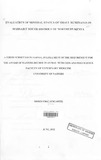| dc.description.abstract | A study was carried out in Merille location of Marsabit South district, Kenya to investigate
Mineral status of sheep and goats under the pastoral production system. The objectives of study the were (i) to assess indigenous knowledge (IK) on mineral nutrition in small ruminants (ii) to identify
the most preferred forage species consumed by small ruminants during wet and dry seasons (iii) to determine the mineral profiles of most preferred forage species and to assess the
.centent of macro and micro minerals in bone and liver tissues. In the first part of the study, a cross-sectional survey was undertaken using a structured questionnaire to gather herder's knowledge on mineral nutrition. In the second part, the most preferred forage species were
. identified by direct observation of 120 young sheep and goats between 0830-1130 hours for six .consecutive days. During each of the seasons, ten forage samples constituting the most preferred forages were randomly collected along the grazing path and analyzed to determine concentrations ofCa, P, Mg , K, Na, Fe, Zn, and Mn.
A composite often most preferred forages was then formulated based on bite counts and analysed for the same minerals. Mineral intake was then computed based on dry matter intake, body weight of the animals and mineral content of the composite. In the third part of the study, twenty-two sheep and twenty-two male goats (14-16 months old) were randomly purchased from three herds/flocks in Merille, slaughtered and whole liver and 12th rib removed. The liver sample was used to analyze for Cu, Fe, Zn and Mn while the 12th rib was analyzed for Ca, P, Mg and Zn. The results showed that herders use specific indicators to detect mineral status of animals and ninety four percent correct salt deficiencies by grazing herds in salty plants, saline water and salt licks. Eighty five percent observed mineral deficiencies during the dry season pastures, while 46% observed mineral deficiencies in the wet season.
Ten most preferred forages represented 88.5% and 85% of dry season forage bites in sheep and goats respectively while in the wet season, preferred forages constituted 76.4 % of sheep and 75.9% of goat's bites. Preferred forages/types showed species and seasonal variation in mineral profiles. Browses had higher levels of Ca, Mg, K, Na and Fe while grasseslherbs were rich in Zn and Mn. The contents of P and K were higher in wet than dry season. In both seasons, sheep and goats had adequate intake of Ca, Mg and low intake of P and K during the dry season. In the case of micro-minerals all animals had adequate intake of Fe, sheep showed low Zn (14.98 mgkg' DM) intake in the wet season and goats had low Mn (18.05 mgkg' DM) intake during the dry season. Liver and bone tissues of sheep and goats indicated adequate body status of Ca, Mg, Cu, Zn, Fe and Mn in the wet season.
In the dry season, sheep showed low hepatic Zn (83.34 mg/kg DM) and Mn (7.54 mg/kg DM) and goats in Cu (236.29 mglkg DM) and Mn (6.85 mg/kg DM) while both species showed low rib Zn and marginal P bone reserves. Based on the information on herders knowledge, mineral intake and liver and bone tissues mineral content it can be concluded that small ruminants suffered from P, K, Zn and Mn and goats in Cu deficiencies during the dry season. The small ruminants would benefit from P, K, Zn and Mn and goats in Cu supplementation during the dry season.
Keywords: Forages, goats, indigenous knowledge, liver, macro and micro-minerals, rib, sheep | en_US |

